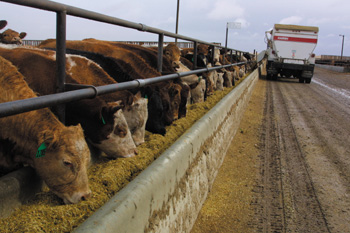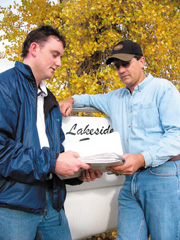
Features
Agronomy
Insect Pests
Nutrient planning impacted by new manure regulations
Crop consultant stresses importance of accurate record keeping.
November 29, 2007 By Top Crop Manager
A new 'Code of Practice' related to manure application that has been introduced
in Alberta is making it more important for growers and their crop advisers to
keep in close, regular contact. The Alberta government developed the Agricultural
Operation Practices Act (AOPA) that established standards and regulations for
manure application for confined feeding operations.
 |
| A significant amount of the nutrients used to produce the silage and grain fed to cattle in feedlots ends up in manure, which can be applied back onto land to help produce new crops. Photo courtesy of Tongue Creek Ranch. |
According to Jason Lindgren, an agronomist with Lakeside Fertilizers located
at Brooks, since the AOPA regulations came into effect in January of 2005, "a
great deal more emphasis is being placed on doing the proper paperwork"
when developing a nutrient management plan for fields that are to receive applications
of manure. Establishing an appropriate manure application rate depends on accurate
soil and manure sampling, as well as on the establishment of realistic yield
goals.
Lindgren stresses the importance of regular communications with his growers
so that they can "keep each other in the loop" if he is to effectively
carry out the record keeping for the fields he is involved with. To develop
an accurate nutrient management plan, he feels it is important that he knows
what is being applied to the fields and what is being removed in the harvested
crop.
As a Certified Crop Adviser, Lindgren proudly points to his on-going, long-term
affiliation with Stephen Anderson of S&K Farms, as an example of the type of
co-operative working relationship that he finds to be effective, as well as
being personally and professionally very rewarding to him. S&K Farms, located
near Scandia, grows sugar beets, corn, alfalfa, beans, wheat and barley. A cattle
feedlot operation provides a source of manure for the farm, although not enough
for the entire farming operation.
Lindgren and Anderson have developed a strategy to maximize the value of the
manure as a soil conditioner as well as a source of nutrients. Since sugar beets
are quite deep-rooted and can scavenge soil-N located at depth, they will not
be planted in a field until three to four years after a manure application.
However, since fields in sugar beet production are prone to wind erosion, an
application of manure following harvest is a high priority.
 |
| Jason Lindgren (left) and Stephen Anderson of S&K Farms meet to discuss harvest progress, to review field records, soil test results and to initiate discussions on developing manure application strategies. |
Anderson stresses the importance of regular contact with agronomic experts
to help him fine-tune the crop production practices at S&K Farms. He cites the
significant contributions of bean and sugar beet specialists when he is growing
those crops. However, for the development of his overall nutrient management
plan, he depends on the positive working relationship and the agronomic services
of Lindgren.
Lindgren's industry peers are also well aware of his excellent agronomic expertise.
This has been fostered by the fact that he and Alvin Stephens, a fellow CCA
at Lakeside Fertilizers, have twice been the gold medal winners of the Agronomic
Retail Olympics that are annually organized by the Canadian Association of Agri
Retailers (CAAR).
In the past, the application of 100 tonnes of manure per acre was pretty standard.
Since the AOPA regulations have come into force, Lindgren states that maximum
application rates are more likely to be in the range of 40 tonnes. As a result
of high previous manure applications, some fields test high in P content. Lindgren
indicates that limiting, or eliminating, fertilizer-P applications to corn and
alfalfa can gradually lower soil-P levels.
His affiliation with Lakeside Fertilizers and research has enabled him to 'get
a good handle' on the N-release rate from manure applications based on local
conditions. As a 'rule of thumb', he expects that 50 percent of the N contained
in manure should be available to the crop if it is fall applied. If the manure
is spring applied, the release rate will be lower and less predictable, so he
likes to monitor the N status of these crops with tissue tests. Soil testing
provides a reliable indication of the amount of N released from manure in future
years.
Irrigated corn for silage production is an important crop in the Brooks region
and Lindgren feels that yields of six tonnes of silage (65 percent moisture)
is a realistic target yield. These silage yields will remove 180 pounds of N
per acre. Besides soil testing, the agronomists working with Lakeside Fertilizers
also provide crop scouting and irrigation management services.
The completion of harvest used to signal the initiation of a legitimate period
of time for celebration and reflection on the fruits resulting from one's labour.
While it is good to be thankful for the completion of another cropping season,
people involved in the agricultural industry find there is now less quiet, idle
time available because the planning and preparation for the next crop starts
as soon as the crop is harvested, if not sooner.
Top Crop Manager regularly carries a story featuring certified crop
advisers from various regions of western Canada. There are more than 700
individuals who have achieved the certification and maintain this designation
through continuing education.